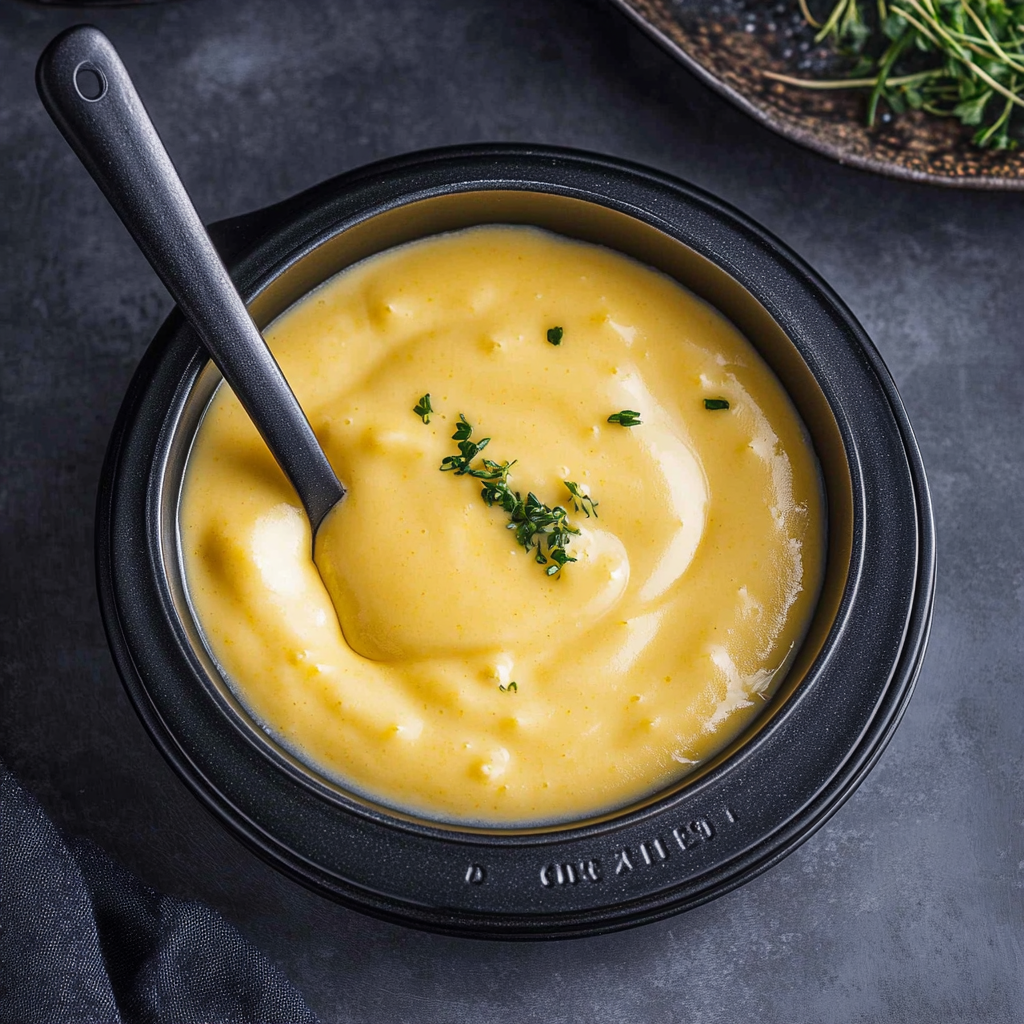Make the best hollandaise sauce in your kitchen. This classic sauce turns simple dishes into amazing meals. It’s easy to learn, and it will make your cooking better.
Creating hollandaise sauce for one is simple. You need just a few ingredients and some skill. It’s creamy and buttery, great with eggs Benedict, veggies, and fish.
Key Takeaways
- Learn to create a foolproof hollandaise sauce
- Understand the basic techniques of sauce preparation
- Discover versatile ways to use hollandaise
- Master a classic French culinary technique
- Impress your family and friends with restaurant-quality sauce
What is Hollandaise Sauce and Its Origin
Hollandaise sauce is a beloved French dish that has been enjoyed for centuries. It’s one of the five main sauces in French cooking. This sauce has a long history that still inspires chefs today.
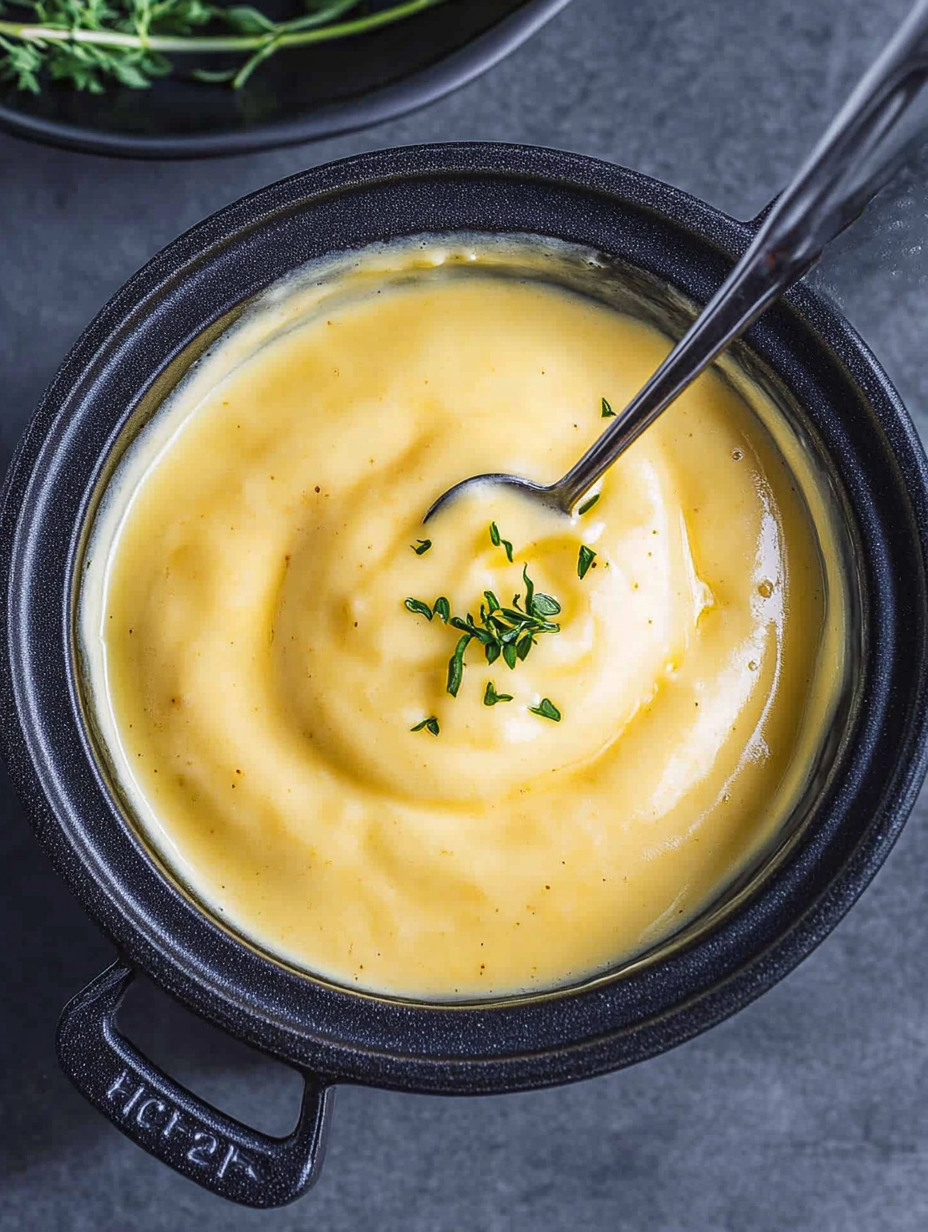
French Culinary Heritage
Even though it’s called Hollandaise, this sauce is truly French. Chefs everywhere admire it for its smooth, buttery taste. Making it well shows a cook’s skill and attention to detail.
Mother Sauce Classification
Hollandaise sauce is a mother sauce in French cooking. This means it’s a basic recipe that other sauces are made from. Learning to make hollandaise is essential for advanced sauce-making skills.
- Originated in French haute cuisine
- Part of the five classic mother sauces
- Requires precise technique to prepare
Historical Development
The story of hollandaise sauce is a bit of a mystery. Historians think it came from earlier European sauces. Over time, it became the creamy, rich sauce we love today. It became popular in fancy restaurants and royal kitchens.
“A perfect hollandaise is the mark of a true culinary artist.” – Classic French Cooking Wisdom
Hollandaise sauce has come a long way from its beginnings. It’s now a favorite among food lovers for its rich taste and smooth texture.
Essential Ingredients for Perfect Hollandaise Sauce
Making authentic hollandaise sauce needs precision and top-notch ingredients. Your sauce’s success starts with the right ingredients. Fresh, quality parts are key for a smooth sauce.

- Egg yolks – The sauce’s emulsifying heart
- Unsalted butter – Go for high-quality, clarified butter
- Fresh lemon juice – Brings a zesty kick
- White pepper – Adds a hint of heat
- Salt – Boosts the flavor
Freshness is crucial for hollandaise sauce. Use room temperature egg yolks for a better mix. European-style butter with more butterfat gives a richer taste.
“The magic of hollandaise is in its simplicity and quality of ingredients.” – Classic French Culinary Wisdom
Want to try something new? Chefs sometimes add cayenne pepper or swap lemon juice for white wine vinegar. These tweaks can give your sauce a unique twist.
Kitchen Equipment You’ll Need
Making a perfect hollandaise sauce needs specific kitchen tools. The right tools can turn a smooth, luxurious sauce into a success. Knowing what tools you need is key to making this classic French sauce.
Essential Tools for Hollandaise Preparation
Here are the main tools you’ll need for hollandaise sauce:
- Whisk (preferably a balloon whisk)
- Double boiler or heat-safe glass bowl
- Saucepan
- Measuring cups and spoons
- Instant-read thermometer
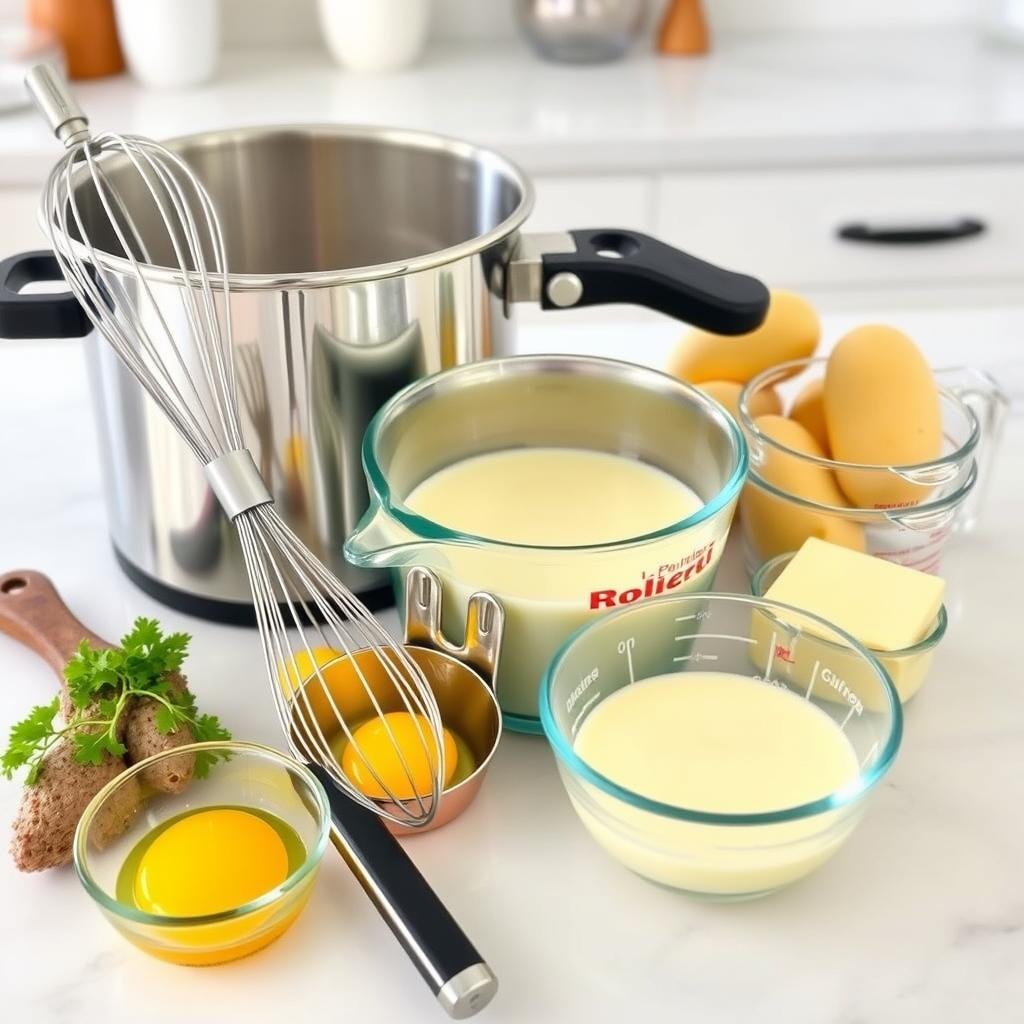
Optional Equipment to Enhance Your Sauce
These tools are not necessary but can make your sauce better:
- Immersion blender
- Stand mixer with whisk attachment
- Electric hand mixer
- Fine-mesh strainer
Choosing the Right Heat Source
Think about your preferred heat source when buying hollandaise sauce ingredients:
- Stovetop (traditional method)
- Microwave (quick alternative)
- Induction cooktop
- Electric hot plate
Pro tip: Consistent, gentle heat is crucial for creating a smooth hollandaise sauce.
Professional chefs say investing in quality tools is important. Whether you’re cooking at home or in a restaurant, the right equipment makes a big difference. It can take your hollandaise sauce from good to amazing.
Step-by-Step Preparation Method
Making a tasty hollandaise sauce is easier than you think. You just need a few ingredients and some careful steps. This way, you can make this classic French sauce at home.
To make a simple hollandaise sauce for one, you’ll need these ingredients:
- 2 fresh egg yolks
- 1 tablespoon warm water
- 1 tablespoon fresh lemon juice
- 1/2 cup unsalted butter, melted
- Pinch of salt and white pepper
Here’s how to make your perfect sauce:
- Prepare the base: Whisk egg yolks with warm water in a heat-safe bowl
- Set the bowl over a pot of barely simmering water, creating a gentle double boiler
- Whisk continuously to prevent egg yolks from scrambling
- Slowly drizzle melted butter while whisking constantly
- Continue whisking until sauce thickens and becomes smooth
“The key to a perfect hollandaise is patience and consistent whisking” – Classic French Cooking Wisdom
Pro tip for your easy hollandaise sauce: Keep the heat low and whisk continuously. If the sauce starts to separate, add a splash of warm water and whisk vigorously to restore its creamy texture.
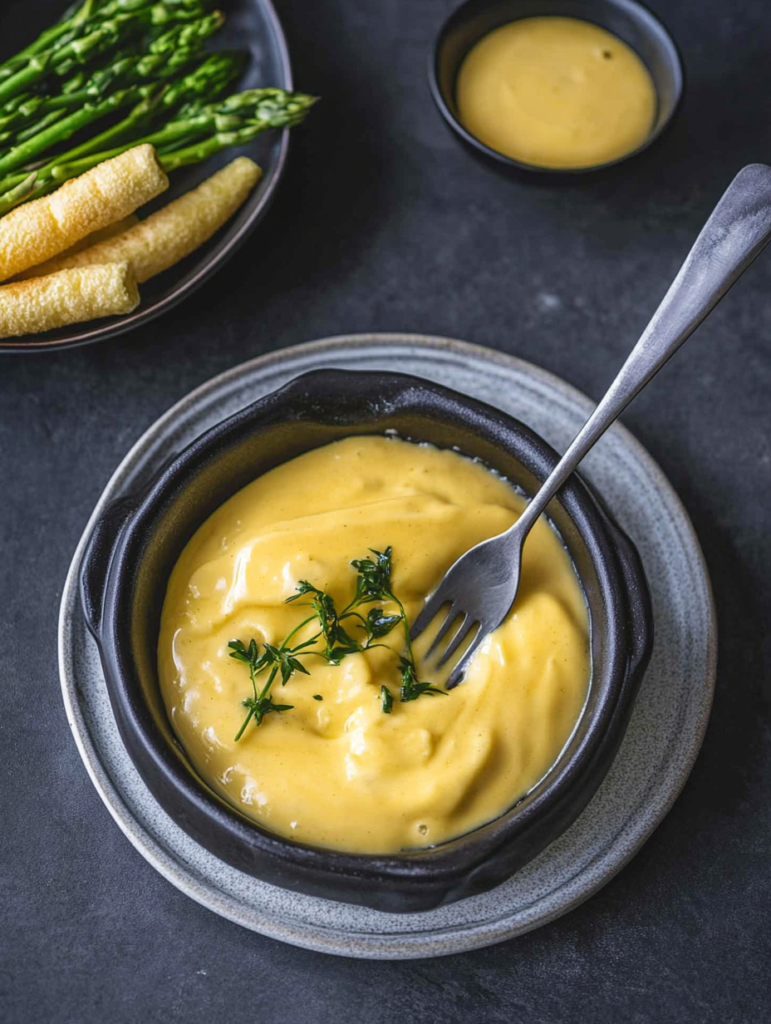
Common Mistakes to Avoid When Making Hollandaise
Making the best hollandaise sauce recipe needs precision and practice. Even skilled home cooks face challenges with this French sauce. Knowing the common mistakes helps you make smooth, tasty hollandaise sauce every time.
Mastering hollandaise sauce means avoiding several key errors. Let’s look at the most common mistakes that can ruin your sauce.
Temperature Control Challenges
Temperature is key when making hollandaise sauce. Here are important temperature issues to watch for:
- Overheating eggs can cause instant scrambling
- Butter that’s too hot will break the emulsion
- Using cold ingredients prevents proper sauce formation
Emulsion Trouble Spots
The balance of hollandaise sauce relies on a stable emulsion. Watch out for these potential problems:
- Whisking too slowly can prevent proper ingredient integration
- Adding butter too quickly can cause sauce separation
- Incorrect whisking technique disrupts sauce consistency
Seasoning Precision
Seasoning is crucial for your hollandaise sauce. Follow these guidelines:
- Use fresh lemon juice for bright, balanced flavor
- Add salt and pepper gradually
- Taste and adjust seasonings carefully
“The secret to perfect hollandaise is patience and attention to detail.” – Professional Chef
By understanding these common mistakes, you’ll be well on your way to creating restaurant-quality hollandaise sauce in your own kitchen.
Classic Uses for Hollandaise Sauce
Hollandaise sauce makes simple dishes into works of art. It adds a rich, creamy touch and a tangy taste to any meal. By using it, you can take your cooking to the next level.
The most famous dish with this sauce is Eggs Benedict. It’s a breakfast classic with a poached egg, Canadian bacon, and hollandaise sauce. It’s a dish that always impresses.
- Seafood Companion: Drizzle over salmon, cod, or halibut
- Vegetable Enhancer: Spectacular with asparagus, broccoli, and artichokes
- Meat Pairing: Delicious with roasted chicken and grilled steak
“A great sauce covers a multitude of culinary sins” – Julia Child
Professional chefs love hollandaise for its versatility. It pairs well with many ingredients, from simple veggies to complex proteins. It elevates any dish.
Get creative with hollandaise sauce. Use it as a dipping sauce, a sandwich spread, or a topping for roasted veggies. It’s a great way to add a special touch to your meals.
Storage and Reheating Tips
Keeping hollandaise sauce fresh is key. Whether you bought it from Woolworths or made it yourself, handling it right is important. This keeps its creamy texture.
Refrigeration Strategies
For the best taste, store your hollandaise sauce right. Here’s how:
- Put it in an airtight container
- Cool it down fast before putting it in the fridge
- Use it within 2-3 days for the best taste
Safe Reheating Techniques
Reheating hollandaise sauce needs care. High heat can mess up its smoothness.
- Warm it up in a double boiler or a bowl over warm water
- Keep stirring while it’s warming up
- Heat it until it’s just warm, not hot
“Gentle heat is the secret to perfectly revived hollandaise sauce from Tesco or any other source.”
Commercial Sauce Considerations
Commercial hollandaise sauces have their own rules. Always check the packaging for how to store it and when it expires.
Pro tip: When in doubt, trust your senses. If the sauce looks or smells off, it’s best to discard it.
Hollandaise Sauce Variations
Exploring hollandaise sauce recipes opens up a world of tasty options. You can turn this classic sauce into something new and exciting. It’s a great way to impress your friends and family.
The best hollandaise sauce recipe is a starting point for many variations. Let’s look at some tasty changes:
- Béarnaise Sauce: A French twist with tarragon and shallots, great for steak and grilled meats
- Mousseline Sauce: A lighter version with whipped cream added to the traditional sauce
- Maltaise Sauce: A citrusy version with blood orange juice
Regional takes on hollandaise sauce show its versatility. Chefs around the world use local ingredients and traditions to create unique sauces.
“Creativity in the kitchen starts with the classic recipe. Then, it’s all about trying new flavors.” – Professional Chef
When trying new hollandaise sauce recipes, think about these tips:
- Add fresh herbs like dill or chives
- Play with different acids
- Use different butters for unique flavors
Your hollandaise sauce can be a blank canvas for creativity. It can turn simple dishes into unforgettable meals.
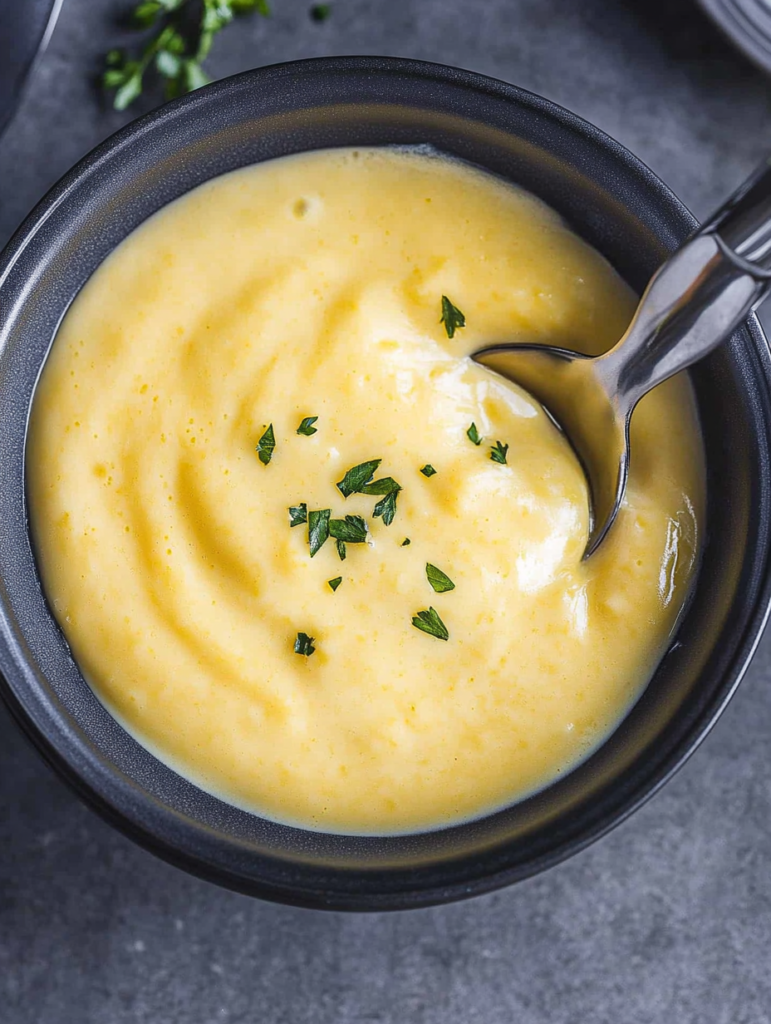
Troubleshooting Your Hollandaise
Making a perfect hollandaise sauce can be tricky for home cooks. It’s okay if it doesn’t work out right away. Even top chefs struggle with this sauce.
Fixing a Broken Sauce
An easy hollandaise sauce can break if not handled right. If your sauce looks grainy or split, try these fixes:
- Remove the sauce from heat immediately
- Whisk in a small amount of warm water
- Use a clean whisk and whisk vigorously
- If needed, start with a new egg yolk and slowly add the broken sauce
Adjusting Consistency
Getting the right texture is key for a smooth sauce. Here’s how to adjust:
- Too thick: Whisk in a few drops of warm water
- Too thin: Whisk over low heat
- Use a gentle heat to avoid more separation
Flavor Enhancement
A great hollandaise sauce has balanced flavors. Try these simple additions:
- A pinch of cayenne pepper for heat
- Fresh lemon juice for brightness
- Finely chopped herbs like chives or tarragon
“Perfecting hollandaise is an art, not a science. Don’t be afraid to experiment!” – Professional Chef
Remember, practice makes perfect. Every try at your hollandaise sauce recipe will get better. You’ll get more confident in the kitchen.
Nutritional Information and Dietary Considerations
Knowing what’s in hollandaise sauce helps you choose better. It’s a creamy sauce with a mix of nutrients.
The ingredients in hollandaise sauce add a lot of calories. A typical serving has:
- Approximately 100-120 calories per 2-tablespoon serving
- High fat content (around 11-13 grams)
- Minimal carbohydrates
- Small protein amounts
When you eat hollandaise sauce, think about your diet. It has ingredients that some people might be allergic to:
- Contains dairy (butter)
- Includes egg yolks
- Not suitable for vegan diets
“Moderation is key when incorporating hollandaise sauce into a balanced diet.” – Culinary Nutrition Expert
But, hollandaise sauce can fit into certain diets:
- Keto-friendly due to high fat content
- Low-carb diet compatible
- Potential modifications for lactose-intolerant individuals
Even though it’s tasty, enjoy hollandaise sauce in small amounts. It’s part of a healthy diet.
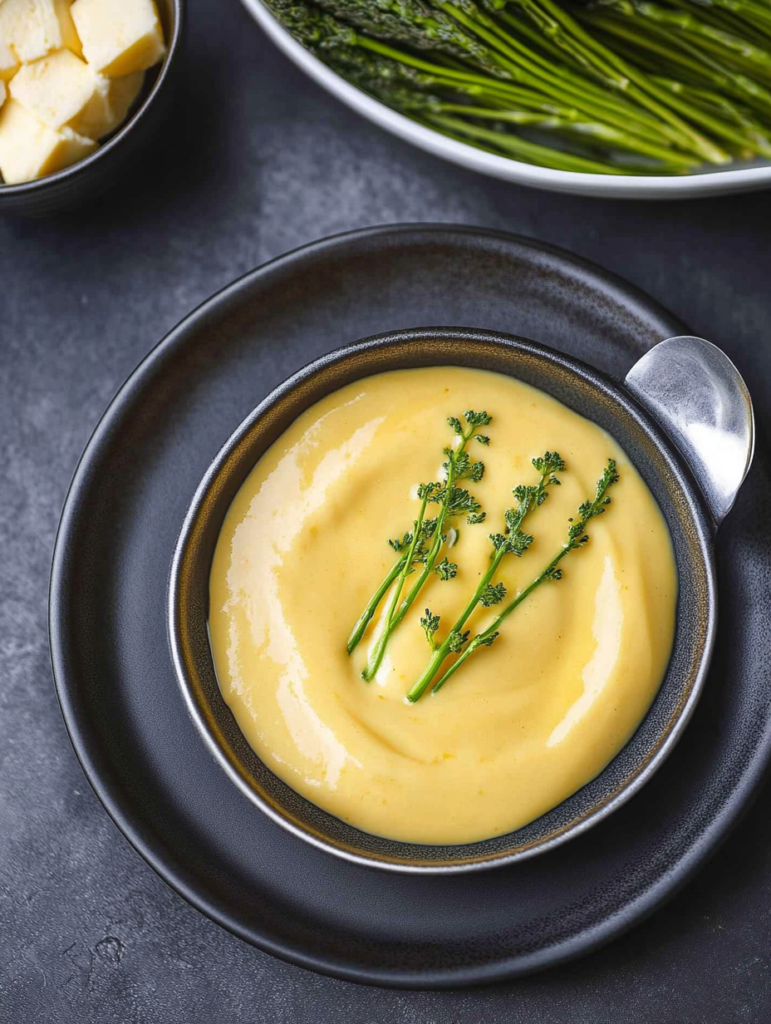
Conclusion
Making classic hollandaise sauce might seem hard at first. But with practice, you’ll find it’s easy to learn. It can make simple dishes into amazing meals.
Hollandaise sauce is very versatile. You can use it in many ways, from breakfast to fancy dinners.
Learning about this famous French sauce shows that with the right skills, you can become a master chef. You can use it on eggs or fish, making your dishes stand out.
Cooking is all about trying new things and having fun. Don’t get upset if you face problems at first. Every try gets you better at making hollandaise sauce.
Start with simple recipes and keep practicing. Soon, you’ll make sauces that wow everyone.
Now you know how to make hollandaise sauce, you can explore French cooking. Your cooking journey is just starting, and hollandaise sauce is a great place to begin.
FAQ
What exactly is Hollandaise sauce?
Hollandaise sauce is a French sauce made from egg yolks, butter, and lemon juice. It’s creamy and smooth, with a tangy flavor. It’s great on Eggs Benedict, steamed veggies, and fish and meat.
Is Hollandaise sauce difficult to make at home?
Making Hollandaise sauce at home can be tricky, but it’s doable. The secret is to slowly add melted butter to egg yolks. This creates a smooth emulsion.
What are the main ingredients in Hollandaise sauce?
Hollandaise sauce needs egg yolks, butter, lemon juice, salt, and sometimes white pepper. Using fresh, high-quality ingredients is key for the best taste and texture.
How long can I store Hollandaise sauce?
You should use homemade Hollandaise sauce within 2 hours at room temperature. Or store it in the fridge for 1-2 days. Always keep it in an airtight container and reheat it gently.
Can I make Hollandaise sauce for just one person?
Yes, you can make a small batch of Hollandaise sauce. Just use one or two egg yolks and less butter and lemon juice.
What are some common uses for Hollandaise sauce?
Hollandaise sauce is very versatile. It’s great on Eggs Benedict, asparagus, salmon, poached fish, and roasted veggies. It’s a must-have for gourmet breakfasts and brunches.
Is Hollandaise sauce healthy?
Hollandaise sauce is high in calories and fat because of its butter and egg yolk. It’s tasty but should be eaten in small amounts. There are lighter versions and alternatives for those watching their calories.
Can I make a dairy-free or vegan version of Hollandaise sauce?
Yes! You can make dairy-free versions with plant-based butter or oils. Vegan versions use cashews, nutritional yeast, and plant-based milk to get the creamy and tangy taste.

